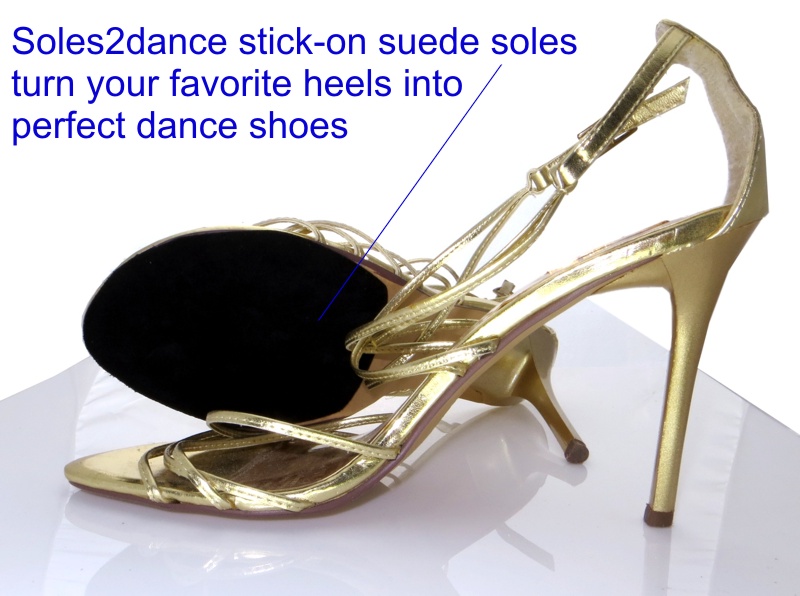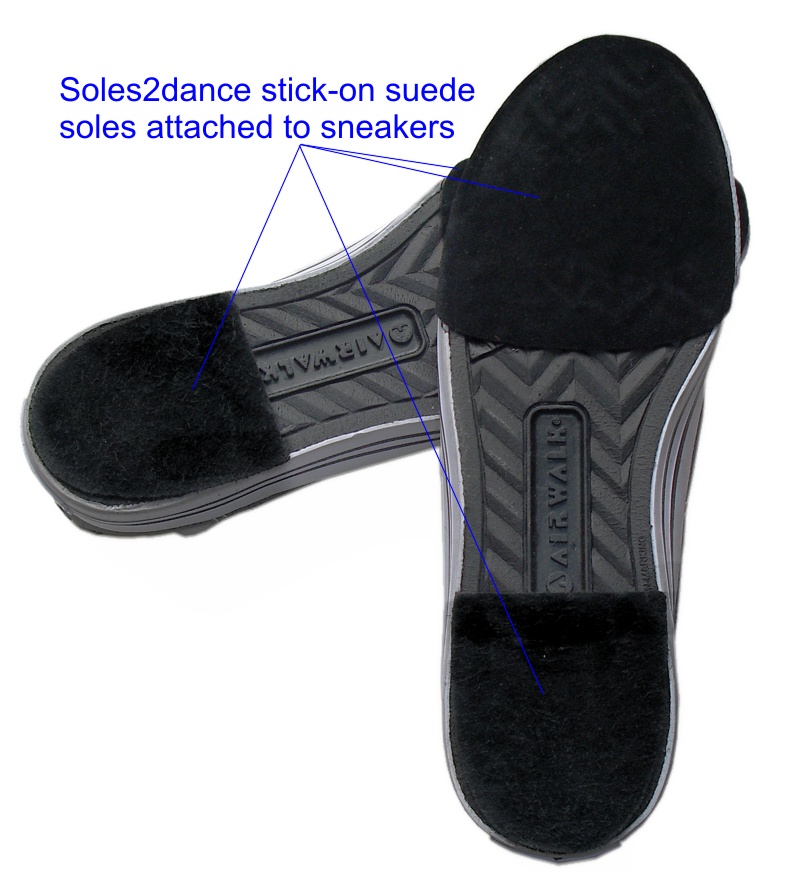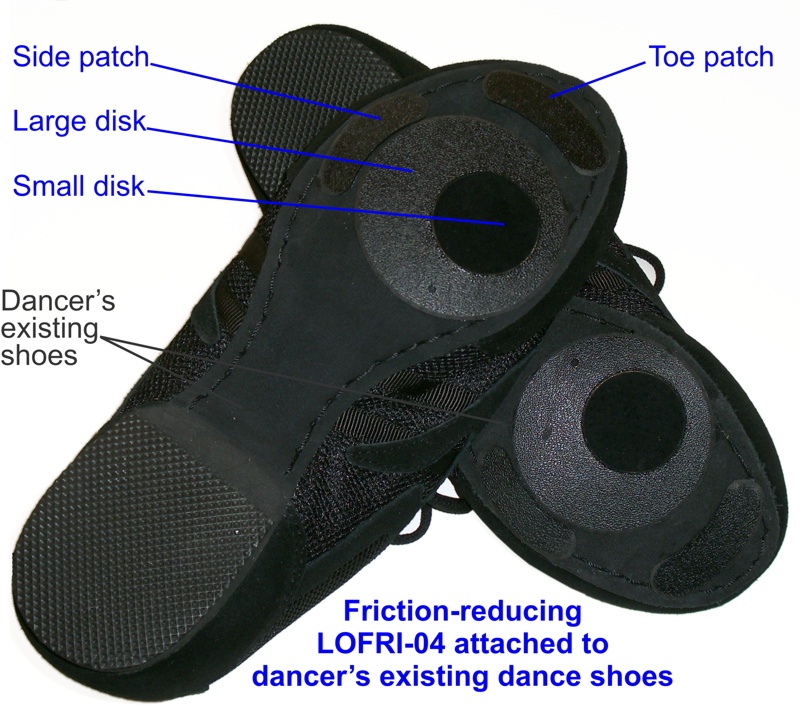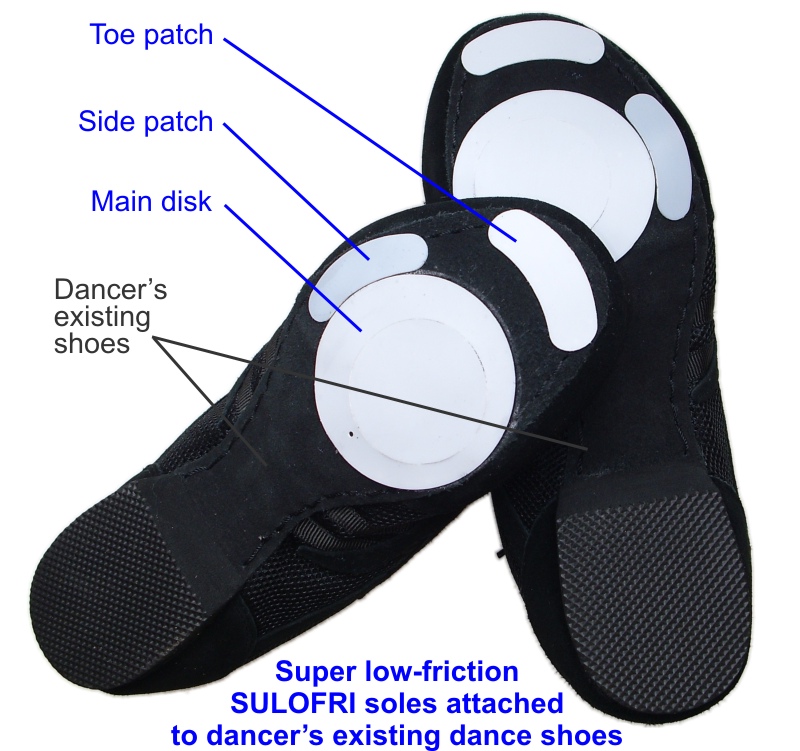Products
Business
|
Welcome to Soles2dance, your premier source for stick-on soles for dance shoes
We
offer two types of stick-on soles for dance shoes: (1) conventional suede
soles and uncut suede sheets for well-groomed wood floors as well as (2) our revolutionary low-friction soles for sticky, high-friction floors or for concrete and asphalt.
All our products, except as noted otherwise, come with industrial-strength 3M 300LSE self-adhesive backing. This makes it easy to apply these products to shoes, without need for messy glues. Below is a summary of the features of our products.
 1. Suede Soles with super-strong self-adhesive backing 1. Suede Soles with super-strong self-adhesive backing
It
is well known among dancers that suede soles work formidably on
well-groomed wood dance floors such as those found in dance studios.
While there are quite a few stick-on suede sole patches sold on the Web,
ours differ from others in that ours are backed by an
industrial-strength double-sided adhesive. This makes it easy for
non-technical dancers to apply these soles to their existing shoes
without having to fuss with messy glues.
All our suede soles are cut by a
sophisticated, computer-controlled laser cutting machine that provides
much greater precision than hand-cutting. As a result, we can show the
exact dimensions of each sole on our product pages, to take the
guesswork out of buying suede soles.2. Low-friction Soles
Low-friction
soles are thin, high-tech stick-on soles that can be attached to the
existing soles
of most dance shoes, street shoes, and exercise shoes, to optimize the
shoes'
friction characteristics for dancing. Our patent-pending hybrid (i.e.,
combining two materials, as shown in the photo on the right)
low-friction soles provide the desirable property of reducing
resistance to pivoting by a lot while still maintaining a good degree
of resistance to
linear slipping, to prevent falls. We offer different versions of
hybrid low-friction soles: Regular low-friction (LOFRI) for most sticky and non-studio dance floors, and super-low-friction (SULOFRI) for outdoor dancing on concrete or asphalt.
 Our
hybrid low-friction soles allow dancers to modify their dance shoes so
that they provide
just the right amount of friction on a wide variety of floors. This is
different from conventional dance shoes that work
well only on well-maintained, clean wood floors. However, many social
dances often take place on less-than-ideal floors that frustrate dancers
because of their high-friction surfaces. Dancers at such events often
complain about pain in their knees, caused by the high torque needed to
overcome the floors' high friction. Dancers also feel that they can't dance at
their best because pivots and turns are limited by high friction.
Similarly, party goers at
nightclubs and other dance entertainment venues typically encounter
dance
floors that are designed more for resilience to street shoes and
spilled
drinks than to promote optimal pivoting, turning, and sliding. For all of these types of floors, our LOFRI-04 product is ideal. Our
hybrid low-friction soles allow dancers to modify their dance shoes so
that they provide
just the right amount of friction on a wide variety of floors. This is
different from conventional dance shoes that work
well only on well-maintained, clean wood floors. However, many social
dances often take place on less-than-ideal floors that frustrate dancers
because of their high-friction surfaces. Dancers at such events often
complain about pain in their knees, caused by the high torque needed to
overcome the floors' high friction. Dancers also feel that they can't dance at
their best because pivots and turns are limited by high friction.
Similarly, party goers at
nightclubs and other dance entertainment venues typically encounter
dance
floors that are designed more for resilience to street shoes and
spilled
drinks than to promote optimal pivoting, turning, and sliding. For all of these types of floors, our LOFRI-04 product is ideal.
 Lastly,
there are outdoor dances on concrete or asphalt where dancing in
suede-soled shoes is entirely out of the question because the suede gets
shredded within minutes. On such abrasive surfaces, rubber and most
other conventional shoe soles produce so much resistance to pivoting and
turning that dancers either have to avoid such moves altogether, or
risk knee or hip injuries while trying to force them. Our SULOFRI product overcomes this excessive friction on concrete and asphalt.
Indeed, dancing on these surfaces with SULOFRI feels almost like
dancing with suede-soled shoes on a well-groomed studio floor.
Click on the "PRODUCT SELECTOR" link just under our company
logo to see which of our stick-on soles will work best with the floors
you'd like to dance on. Lastly,
there are outdoor dances on concrete or asphalt where dancing in
suede-soled shoes is entirely out of the question because the suede gets
shredded within minutes. On such abrasive surfaces, rubber and most
other conventional shoe soles produce so much resistance to pivoting and
turning that dancers either have to avoid such moves altogether, or
risk knee or hip injuries while trying to force them. Our SULOFRI product overcomes this excessive friction on concrete and asphalt.
Indeed, dancing on these surfaces with SULOFRI feels almost like
dancing with suede-soled shoes on a well-groomed studio floor.
Click on the "PRODUCT SELECTOR" link just under our company
logo to see which of our stick-on soles will work best with the floors
you'd like to dance on.
For an informal discussion on why dancers need this product, click the Blog link on the top menu.
All of our kits work well with popular dance
styles including Ballroom, Salsa, Merengue, Hustle, Swing, Lindy,
Hip-Hop, Line Dancing,
Street
Dancing, Freestyle, and, especially close to our hearts but strangely
unpopular:
The Bump.
|
|
|